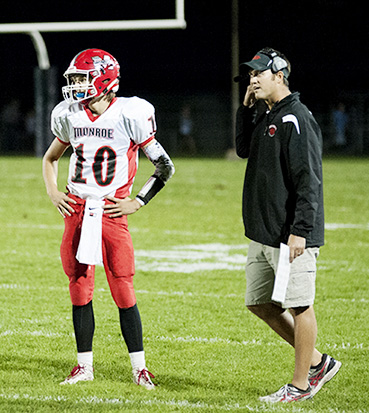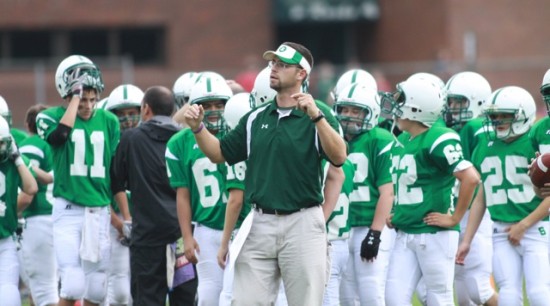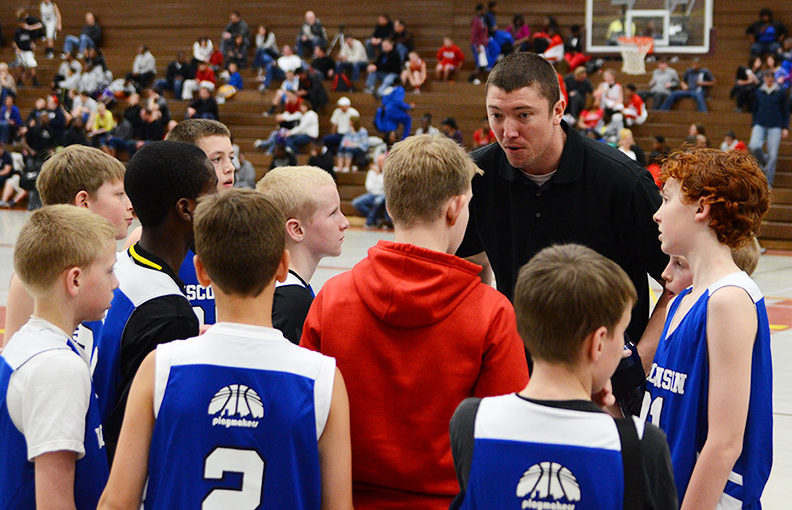Strengthening the connection between coach and team captain
Duke men’s basketball coach Mike Krzyzewski hit the nail on the head when he said, “You don’t just need a leader. You need a leadership team.”
 Ultimately, your team functions best and has the greatest chance of winning when you and your captains work together as a strong leadership team. Unfortunately, coaches and captains aren’t always on the same page because they often don’t invest the necessary time to communicate with each other.
Ultimately, your team functions best and has the greatest chance of winning when you and your captains work together as a strong leadership team. Unfortunately, coaches and captains aren’t always on the same page because they often don’t invest the necessary time to communicate with each other.
Your captains are the critical connection between the coaching staff and the rest of the team. You need your team leaders to understand what you are trying to accomplish as a program, be the best examples of your team’s culture, help sell the team on your vision and hold people accountable who aren’t living up to them. These things don’t just happen by chance but through developing a strong partnership with your team leaders based on mutual trust and respect.
Based on suggestions from captains themselves, here are 10 things coaches can do to strengthen their connection with captains.
1. Proactively identify and develop leaders.
One of the first things you can do to connect with leaders is to proactively identify them and let them know how much you believe in them as a current or future team leader. As Michigan gymnast Annette Miele said, “I gained so much confidence as a team leader when my coach asked me to be a part of the Leadership Academy. I knew my coach believed in me and my leadership.”
Just telling your athletes you see them as current or potential team leaders inspires a tremendous amount of confidence in them. Knowing that they have your support and backing helps validate them as leaders in their minds. Most want to step up to the challenge and prove to you they are worthy of your respect as a leader. Expressing your confidence in them is an early important step in building a connection.
2. Discuss the responsibilities, risks and rewards.
Once you identify your leaders, invest the time during your offseason or at the start of preseason to discuss your expectations of them. We do something called “onboarding” in our Leadership Academies that comes from the business world. Onboarding is a 10-step process that is designed to bring leaders up to speed so they are ready for their all-important first 30 days of leadership and beyond.
The first three steps of onboarding asks the captains and coaches meet to discuss the specific responsibilities, risks and rewards of leadership. Coaches are asked to come up with their list of the top 10 responsibilities they need most from their leaders throughout the year. Captains do the same and the two groups compare notes so they are crystal clear about what is expected of each other. They also discuss the risks and challenges of being a team leader and the many benefits that strong leadership brings to the team.
This candid discussion about the responsibilities, risks and rewards of clarifies expectations on the front end and helps solidify the bond of the leadership team.
 3. Weekly check-ins.
3. Weekly check-ins.
One of the absolute best things you can do to build and strengthen your coach-captain connection is to schedule regular check-ins with your team leaders on a weekly basis. As one captain said, “We meet with our coaches every week throughout the year. We discuss issues going on in our team, positive things that are being accomplished and how we can each improve to help take our program to the next level. Our coaches are there to offer advice and, for the most part, really listen to what we have to say.”
These short, weekly meetings don’t have to be long but they keep everyone connected with what is going on. They provide captains and coaches with a chance to check in with each other to share successes, bring up any concerns, and develop a unified focus and plan of attack for the week. This dedicated time of just 10-15 minutes to communicate and connect is essential for creating a strong leadership team.
4. Start a book club.
A great way to connect with your leaders and develop their leadership skills is through a book club. Assigning your leaders a common book to read and discussing the chapters on a regular basis not only introduces them to new insights on leadership but it also allows you to see how the ideas specifically apply to your leaders and team.
No matter which book you use, a book club provides an excellent platform and discussion forum for you and your leaders.
5. 360 feedback and individual leadership coaching.
In addition to meeting with your leaders as a leadership team, I also recommend meeting with them occasionally on a one-on-one basis to discuss their development as leaders. Just as you coach them on their physical skills, you can also coach them on their leadership skills.
We provide our leaders with a customized “leadership 360 evaluation and report” on their leadership skills and encourage them to go over it with their coaches. It provides the coach and captain with an opportunity to discuss the leader’s particular strengths and areas to improve. As one captain said, “My coach and I met about my 360 evaluation. This allowed me to understand what he wanted from me and created a good communication and connection between us.”
6. Allow input on rules, rewards and punishments.
Ask captains to provide input on your team rules, rewards and punishments. Since your captains are the people who play a big role in enforcing the rules and standards of your team, provide them with the opportunity to help establish them. As one captain said, “Anything that had to do with the team, myself and my co-captain were always asked our opinions before any decisions were made. This also helped our coaches because they got to hear the perspective of a player.”
What you may find is that your captains come up with stricter standards than you might have on your own. You don’t need them to create a laundry list of rules to cover every possible scenario. You just need them to establish some important standards and make sure they are enforced.
 7. Let the leaders lead.
7. Let the leaders lead.
They can lead stretching during warm ups, help with announcements to keep the team in the loop and be the leaders during competitive drills.
To enhance competitiveness and keep practices interesting, some teams create sub-teams within the team to compete against each other. University of North Carolina women’s lacrosse, football and softball all have created teams within their teams that are run by their leaders. Some teams have the leaders draft their teammates while others mix up the teams according to their year in school or position so they get a chance to know other segments of the team. The smaller teams then compete in various challenges in practices, weight lifting, community service, Wiffle ball or pumpkin carving. Not only does the intra-team competition spice up practices and connect people from different segments of the team, it provides leaders with a chance to practice their leadership skills in a small group setting.
8. Communicate before team meetings.
In providing captains with opportunities to lead, sometimes it’s best to arrange a meeting with them before having one with the entire team. Krzyzewski provided a great example when he coached the Olympic team.
“Prior to our standards meeting, I had met individually with Dwayne (Wade), Kobe (Bryant), LeBron (James), and Jason (Kidd). I knew that this upcoming team meeting would set the tone for the rest of our time together. I knew it had to go well. To be a good builder of teams, you need to identify these crucial moments and take the necessary measures to ensure that they accomplish what you intend.
“Separately, I told each of these four guys that we were going to have a team meeting about how we would live on a day-to-day basis. I let them know I planned to open it up to the players and staff for input. ‘I need you to speak,’ I told them. ‘Say anything you want to say. But say something. And speak from the heart.’
“You cannot assume that people are automatically going to speak up. But by making certain that someone will, you create an atmosphere conducive to contributions from everyone. The fact that I had these individual meetings prior to the team meeting does not mean I told them to say what I wanted to hear. It’s not about that. It’s about making sure that you fully prepare for impact moments the right way. If we are having a team meeting for the specific purpose of developing team standards and no one speaks, those standards take on the appearance of rules. You have to give your team the opportunity to contribute to your collective identity. And they did.”
Remind players how influential their words and opinions are to the rest of the team.
9. Have candid, confidential conversations.
You and your captains will need to establish a trusting environment where you have each other’s backs. You will need to talk about real issues that impact your team and cut to the heart of the matter.
This necessitates candid conversations where the unvarnished truth is revealed, discussed and embraced. You must develop a mutual understanding and agreement that you will keep things confidential in your discussions with each other. What is said behind closed doors must stay behind closed doors.
Just as you will protect and defend your captains, you also expect your captains to protect and defend your coaching staff when a teammate questions your decisions. As Ben Franklin said, “We must all hang together or we will all hang separately.” This is especially true when it comes to captains and coaches sticking up for each other.
10. Don’t shoot the messenger.
Captains will likely bring up problems and issues that you don’t want to hear. If they trust you, they will tell you about some alcohol and drug issues of some of your athletes. If they trust you, they may tell you that you think you are playing favorites with certain athletes. And if they trust you, they may tell you that they think you went overboard in being critical of a certain teammate and it has destroyed his or her confidence.
If you want to maintain your critical connection with them, you must be careful not to shoot the messenger when you hear difficult information from them. Shooting the messenger means blaming your captains for revealing the problems and taking your frustration, anger or embarrassment out on them. Not only will it shut down their willingness to share future information with you, it will likely strain and perhaps even sever your connection with them. Be the bigger person and thank your leaders for sharing the information with you.
The coach-captain connection is a critical one on a variety of levels. Rather than hoping you have a good relationship with your leaders, proactively invest the time to communicate and connect with them throughout the season. Not only will this partnership better connect you with your team, you will have key allies who can influence and impact your team in a positive and productive way.
For more info on helping your team win championships, visit www.JanssenSportsLeadership.com.





